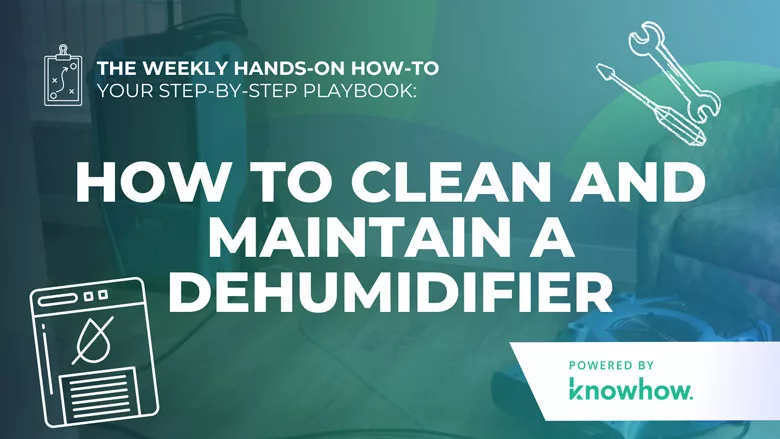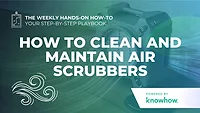Weekly Hands-on How-To powered by KnowHow
How to Clean and Maintain a Dehumidifier
Keep Your Dehumidifiers Running Like New: A Step-by-Step Maintenance Guide

Images provided by KnowHow.
Dehumidifiers are workhorses on the job site—quietly pulling moisture from the air to keep materials dry and prevent mold growth. But like any piece of equipment, they need regular cleaning and maintenance to keep running efficiently and avoid costly breakdowns.
In this weekly how-to guide, powered by KnowHow, we’ll walk you through the full dehumidifier breakdown and maintenance process—from inspection and cleaning to reassembly—so you can keep your units in top shape and ready for any job.
Step 1: Inspect the Power Cord
Start with a quick safety check. Examine the power cord for signs of fraying, exposed wires, or melted insulation. A damaged cord can pose a fire or shock risk, so make sure it's securely connected and shows no wear.
If anything looks questionable, tag the unit out of service and report it for repair or replacement.
Step 2: Check for Visible Damage or Blockages
Before taking the unit apart, give it a thorough visual inspection. Look for:
- Cracks or damage to the housing
- Dust buildup around air intake vents
- Blockages in the drainage hose or tank area
Catching visible issues early helps prevent bigger problems during operation.
Step 3: Unplug the Dehumidifier
This may sound obvious, but it’s worth emphasizing: always unplug the unit before maintenance. This step protects both you and the equipment from electrical hazards.
Step 4: Remove and Clean the Air Filter
Locate the air filter—usually found behind a panel or grille—and remove it gently.
To clean:
- Use a vacuum to remove loose dust and debris.
- For deeper cleaning, rinse with warm water and mild soap.
- Let it dry completely before reinstalling.
A clean filter improves airflow and protects internal components from dust buildup.
Step 5: Clean the Water Collection Tank or Pump
Remove the tank or pump tray, empty any standing water, and inspect for buildup or biofilm.
To clean:
- Wash the tank with warm soapy water, making sure to scrub all corners.
- Rinse thoroughly and air dry before reinserting.
For pump systems, ensure the drain lines are clear and flowing properly.
Step 6: Check and Clean the Coils
Access the unit’s evaporator and condenser coils, typically located behind the front grille.
- Use a soft brush or vacuum with a brush attachment to remove dust and debris.
- Avoid using metal tools or abrasive brushes, which can damage the fins.
Dirty coils reduce efficiency and increase wear on the compressor.
Step 7: Use an Air Compressor to Blow Out the Interior
With the panels removed, use an air compressor to blow dust out of:
- Coils and fan blades
- Motor housing
- Tight interior corners
Use short, controlled bursts of air, and avoid pointing the compressor directly at wiring or delicate components.
Step 8: Reassemble the Dehumidifier
Once everything is cleaned and dry, reassemble the unit:
- Replace the air filter and water tank
- Reattach grilles and panels
- Ensure all components are securely in place
Finally, plug it in and do a test run to ensure it's operating smoothly.
Keep Your Equipment Running Like It Should—with KnowHow
A well-maintained dehumidifier doesn’t just run better—it lasts longer, works more efficiently, and keeps jobs on schedule. Staying on top of routine cleaning and inspections helps you avoid costly breakdowns and ensures your drying equipment performs when it matters most.
That’s where KnowHow comes in. With step-by-step maintenance procedures, cleaning checklists, and instant access to your company’s equipment SOPs, KnowHow gives your crew the tools to stay consistent—no matter who’s doing the work.
Ready to standardize your equipment care and avoid downtime? Visit tryknowhow.com and see how KnowHow helps restoration teams keep the job moving and the gear in top shape.Looking for a reprint of this article?
From high-res PDFs to custom plaques, order your copy today!







